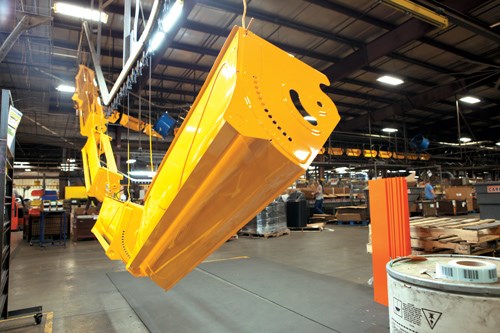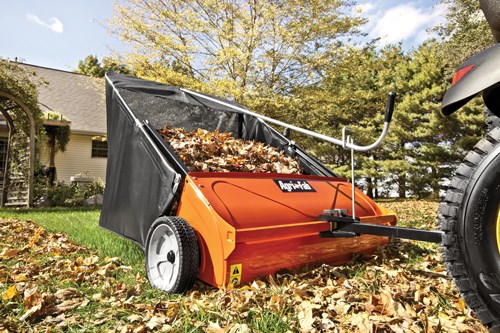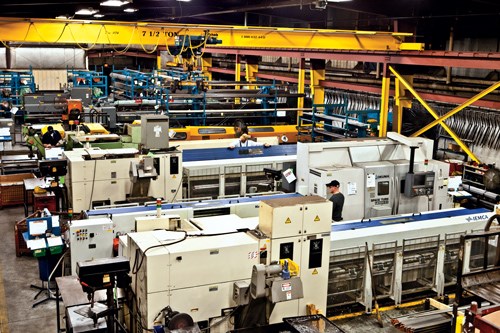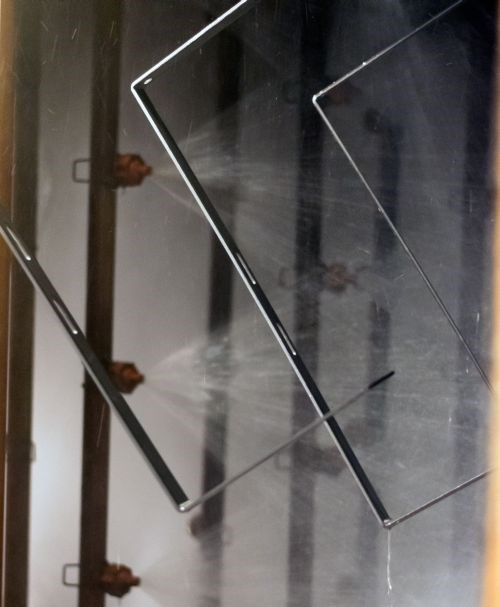Greener Grass Through Pretreatment Changes
Manufacturer Agri-Fab changes pretreatment for zero discharge to save on energy costs and meet customer needs.
Some of the best-looking lawns in the United States got their start at a manufacturing plant in Sullivan, Illinois, where the employees at Agri-Fab make the tools that make yardwork look easy.
Agri-Fab is best known for making lawn care products such as sweepers, spreaders and lawn carts, both for its own line of products, as well as for other major OEMs, such as John Deere.
The 300,000-square-foot facility—which houses AF Manufacturing—offers all types of manufacturing services such as machining, laser, stamping, welding, assembly, tooling, tube bending/forming and coatings.
The quality is such that, last year, Agri-Fab received John Deere’s Achieving Excellence Partner award, as well as the John Deere Service Parts Supplier of the Year award.
“Agri-Fab is willing to do whatever it takes to meet customer demand,” says Gerlanna Patterson, a John Deere supply chain manager who spoke to Agri-Fab employees at a lunch to celebrate the awards. “They consistently align with John Deere goals and processes. Agri-Fab is up to the challenge.”
Recently, that challenge included making major changes to its coating operations, specifically becoming a zero-discharge phosphate operation and achieving John Deere F17-approved supplier status, better known as JDM F17, an enterprise specification for paint performance.

Parts move along the coating line at Agri-Fab.
Pretreat Change
Changing its pretreatment had been discussed for some time since the town of Sullivan had started regulating phosphates in its treatment plants, which meant that soon Agri-Fab would be unable to discharge direct to the municipal sewer.
“We had been looking internally at some changes we wanted to make to our system, and going to zero discharge was one of them,” Doug Moore, an Agri-Fab manufacturing engineer, says. “A lot of those changes were to meet our customer’s requirements, not only in process but in the coatings.”
Sullivan allows up to three parts per million phosphorous in a discharge, and Agri-Fab has been using an iron phosphate system that Moore says was generating a lot more than what was allowed, which meant the company was paying a fairly large fee to dispose of the contents off site.
Of equal importance was meeting the JDM F17 paint performance requirements for John Deere products, which defines specifications for simple parts, assembled components and fully assembled equipment.
JDM F17 called out corrosion resistance standards such as salt-spray, cyclic corrosion and humidity resistance. It also set physical property requirements for primers and topcoats, including pencil hardness, dry adhesion, elongation and impact resistance. In addition, certain chemical resistance requirements—for items such as engine oil and coolant, as well as gasoline and diesel fuel—also needed to be met.
“So we had our customer needs and we had our own internal needs to change our system, including trying to save energy costs by going to something with more of an ambient temperature for the the washers and the baths,” Moore says.

Agri-Fab makes lawn care products such as sweepers, spreaders and lawn carts.
Zero Discharge
In late 2014, Agri-Fab met with Calvary Industries, Inc. (Cincinnati, Ohio) about working to convert its pretreatment line to get to the zero discharge requirement for phosphates, as well improving efficiencies and lowering costs.
Tom Boland, Calvary’s sales manager for its central region, says that the pretreatment process that Agri-Fab was using was a traditional detergent iron-phosphate, commonly referred to as a cleaner/coater. It was also running an acidic sealer in the final stage.
“Our recommendation was to go to a 5-stage process that included some newer chemistries that would meet the company’s needs, and save them operating costs,” Boland says. “It would also give them a greater level of control of their finishing operations.”
Agri-Fab needed to be consistent in its coating applications for the markets it served, which included pulley products, commercial seating, grain and livestock, utility vehicle equipment, lawn and garden, tractor transmission, riding lawn equipment, heavy equipment, water utilities, fitness, oil pipeline, hand tool tubing and snow removal.
Quality in its manufacturing process—and specifically how its coatings applications have held up in very harsh conditions—has been a trademark of Agri-Fab since 1975, when the original owner, Yardman, sold the product line to MTD-Cleveland and closed the factory. That’s when six of the Yardman staff members—along with other members of their local church—purchased the facility and equipment and convinced MTD to invest in Agri-Fab as a joint venture.
Ron Harshman, who is current chairman of the board of AF Holdings, was one of the original six who started the venture. It was in 1982 that Agri-Fab decided to sell directly to mass merchandisers, which lead to the development of new products, including the redesign of a dual-stage lawn sweeper that surpassed Sears’ sweeper in its own testing, thereby winning “Sears’ Best” recognition.

Agri-Fab’s paint line earned the John Deere’s Achieving Excellence Partner Award.
Expansion
With that early success, Agri-Fab began expanding its manufacturing capabilities in the early 1990s to meet customers’ potential needs. The company acquired Clark Pulley in Russellville, Alabama, and launched Hydro-Gear in a partnership with Sauer-Sundstrand to build transmissions, pumps and transaxles, success which has seen Hydro-Gear grow to facilities in eight states, Europe and China.
Just as Agri-Fab was starting to grow, it saw intense regulations on liquid-paint spraying that soon required large manufacturing operations to convert to a high-solids paint, which, at the time, caused Agri-Fab a large expense and operational issues.
In the early 1990s, the company installed four powder coating spray booths in a newly constructed paint building, which eliminated air pollution and hazardous waste, while increasing customer satisfaction because of the improved quality of its product’s appearance.
Sean Ruppert, director of marketing for Agri-Fab, says that at peak season the company has nearly 400 employees, which is impressive in a town of 4,700. Nearby, Hydro-Gear employs nearly 700, which makes AF Holdings one of the most important companies in the region.
The Agri-Fab facility today has some of the most advanced fabrication and machining technology on any shop floor, as well as lasering, tube bending and welding.
The finishing line consists of a dip paint line and dual powder coating lines. The liquid line applies a black baked enamel with a part window of 24 by 48 by 12 inches, with a 70-pound rack limit. The total weight through is about 560 pounds per minute, or 34,000 pounds per hour. The powder lines have a 40 by 60 by 24-inch window and the racks can handle up to 200 pounds. The line includes four Nordson spray booths and a Gema Quick Change powder booth.

Agri-Fab uses Calvary’s Cal-Eye 1000 chemical automation and computing system because of its simplicity of use, data collection properties and customization possibilities.
Reducing Costs
But, of course, the main concern for Calvary and Boland was to get the new pretreatment line in and operating so that Agri-Fab could meet all its needs and start reducing costs, too.
Boland says that Calvary’s technical team understood that many alkaline cleaners contain tetrapotassium pyrophosphate, so they constructed a phosphate-free alkaline cleaner, which contains properties to clean equally well, but sludge substantially less.
The company selected Calvary’s Cal Clean 944NP, Advantech 610A and S1488 for the chemicals in the treatment baths, enabling the entire pretreatment system to be 100 percent phosphate free. The 610A brand is a zirconium treatment and the S1488 is a non-chrome seal rinse.
“We decided to use 610A and S1488 because of its performance characteristics, as well as having been previously approved in a John Deere painting process,” Boland says.
It was also during this time that Agri-Fab learned of the Calvary’s Cal-Eye 1000 chemical automation and computing system, mostly because of its simplicity of use, data collection properties and customization possibilities.
The basic part of the system monitors washers and ovens, plus provides for automated chemical feed, as well as logging downtime. The system can be expanded to include items such as paint, conveyor, parts tracking and wireless film thickness reading.

Agri-Fab selected Calvary’s Cal Clean 944NP, Advantech 610A and S1488 for the chemicals in the treatment baths.
More Uniformity
“The system maintains more uniform chemical concentration to reduce costs, while improving quality,” says Austin Morelock, business development manager for Calvary Industries. “It reduces gas use by using an energy saving mode when parts are not being processed. Knowing what and where parts are on the line can initiate cost saving procedures and production information.”
Moore says that every adjustment was previously done by hand, so stepping up into an automated system was a big improvement.
“We were managing the pH levels and the concentration of just one solution ourselves,” Moore says. “But with the new system, we can generate many reports and look at any trending that may be occurring so that we can address them quickly.”
The system was validated through testing that was conducted using an independent outside paint supplier and Agri-Fab put the line into operation.
“We got the line to run pretty much the way we wanted it to fairly quickly,” Moore says. “As with everything new, we had some time to see if the output numbers would reflect what we thought we would get, and everything was very positive.”
Agri-Fab saw a little higher evaporation rate than it had run in the past, but because they are running both powder coating lines through the same pretreatment system, they always have a higher coating rate than other similar shops.
Todd Harris, Agri-Fab’s contract sales manager who works with clients such as John Deere, says it has been great for his company to let current and potential customers know about its equipment and technology upgrades.
“Without question, it is a good thing that we can meet their specifications and requirements very well,” he says. “They are always wanting to make sure we have those capabilities.”
The byproduct, too, is how Agri-Fab has improved its environmental impact and energy usage, a question that many OEMs ask their suppliers.
“We are confident that our paint system performance exceeds industry norms, and in our market we are still ahead of the curve,” Moore says.
For information on Agri-Fab and AF Manufacturing, visit agri-fab.com. For information on Calvary Industries, visit calvaryindustries.com.
Originally published in the May 2016 issue.
Related Content
Practical Environmental Management Reduces Costs, Refines Quality
By focusing on effluent treatment and efficient tin recovery, this Indian surface treatment plant meets stringent environmental standards and sustainable high-quality production.
Read MoreRevolutionizing Battery Production for Electromobility
Fully automated process combines ultrafine cleaning and protective UV coating for battery cells, replacing the need for traditional film wrapping.
Read MorePPG Paints, Coatings for Battery EVs Showcased at Germany Battery Show
PPG is attending The Battery Show in Stuttgart, Germany.
Read MoreOnline Energy Savings Calculator Promotes Energy Efficiency
An online energy savings calculator from AkzoNobel aims to help customers determine how to reduce energy usage.
Read MoreRead Next
Full-Throttle Pretreatment at Yamaha's Ecoat, Powder Coating Line
SEE THE VIDEO: A Cross Functional Team Makes a Change in Yamaha’s Pretreatment Line With Help From Supplier Calvary Industries
Read MoreEpisode 45: An Interview with Chandler Mancuso, MacDermid Envio Solutions
Chandler Mancuso, technical director with MacDermid Envio discusses updating your wastewater treatment system and implementing materials recycling solutions to increase efficiencies, control costs and reduce environmental impact.
Read MoreA ‘Clean’ Agenda Offers Unique Presentations in Chicago
The 2024 Parts Cleaning Conference, co-located with the International Manufacturing Technology Show, includes presentations by several speakers who are new to the conference and topics that have not been covered in past editions of this event.
Read More





















